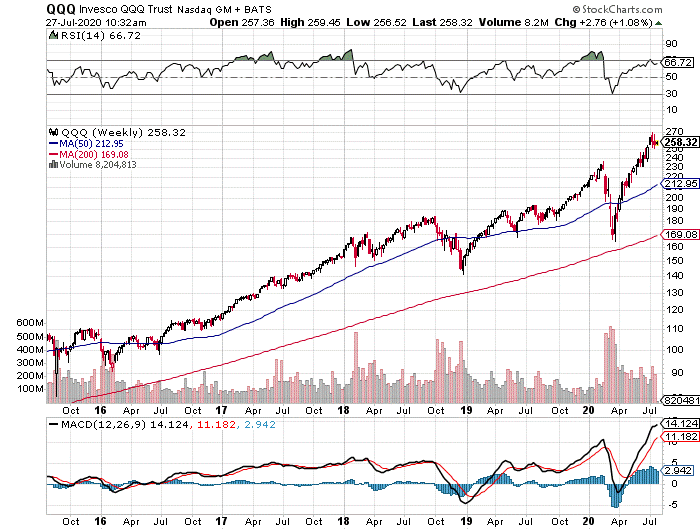The Great Reopening Trade 2.0
By: Bryan Perry,

The buildup to second-quarter earnings season was accompanied by some steady moves higher among the leading mega-tech stocks.
Indeed, only beat-and-raise financial guidance would have kept the party going. However, some early season results failed to impress, and the overcrowded big-cap tech trade is finally letting off some steam as July ends.
It is pretty much a case of buying on the rumor and selling on the news. Big money then typically regroups in the latter part of August or early September and starts to bid high-quality tech stocks up for the balance of the year, especially in the fourth quarter. This is, and historically has been, the “run for the roses” year-end pattern.
I suspect that this time around, it will be different — very different. Yes, there are super secular trends in place — 5G, Internet of things, cloud computing, cybersecurity, artificial intelligence, augmented reality, autonomous driving, enterprise networks, e-commerce fintech, mobile streaming and more. But, there is a year-end trade in the works, in which the tech sector will likely be the source of funds.
CNBC has trotted out the usual parade of analysts in order to reassure the viewing audience that the tech sector holds our future working and personal lives, as well as the future performance of the stock market. However, nothing has changed except the fact that we’ve entered a period of short-term consolidation. Here, the operating phrase is “short-term.” And while the first part of this declaration is true, I’m calling the second part into question.
First of all, the NASDAQ 100 is trading at a very lofty valuation. According to the Wall Street Journal, as of July 26, the NASDAQ 100 Trust ETF (QQQ) was trading with a price-to-earnings ratio (P/E) of 37x. The NASDAQ 100 index was trading at just below 3.3 times the value of the S&P 500. The last time the index traded at this valuation versus the S&P 500 was on March 10, 2000, exactly two weeks before the bottom fell out.
This is the most crowded trading session in history, with five stocks accounting for 40% of the NASDAQ’s total weighting and 20% of the S&P 500’s overall weighting. Unless these companies are forced to break up, it is hard to imagine the numbers changing unless some air comes out of the big five’s balloon. They are considered “safe-haven” stocks as they feature defensive business models and guaranteed double-digit-percentage earnings growth.
I am not calling for a trapdoor selloff, just a longer-than-anticipated cooling-off period that will be dramatically interrupted by massive sector rotation. I believe that there is a serious groundswell in the making, and that it will be one that will cause the ground to shift underneath the tech sector. In fact, it may have already started with last week’s 5% pullback in the NASDAQ 100. This because it signaled an August retreat from the highs.

There are two developments that, in my view, will trigger a tsunami-sized sector rotation. The race for a vaccine to defeat the coronavirus is starting to indicate that there could be one ready for mass production by the year’s end. And, there is also a rising tide of tension toward China, which I don’t see dissipating anytime soon. In fact, it will only simmer further into the teeth of the election cycle.
The advent of a vaccine that can be delivered on a wide scale will trigger a huge buying spree into all types of reopening stocks — hotels, restaurants, airlines, cruise ships, casinos, hair salons, fitness clubs, childcare, railroads, hospitals, medical devices, materials and brick-and-mortar retail.
This has the potential to be one of the great slingshot trades of the past decade, as these stocks have been crushed for a second time this summer. As a result, the majority of them are sitting at or just above their March lows. This is not an earnings-driven trade, one that is based on who will win the election, how low the dollar trades against the euro, whether big-cap tech companies are forced to split up or how much more quantitative easing (QE) the Fed is going to use to stoke the corporate bond market with serial purchases. This is a perception trade.
When discussing the stock market, most of us are quite familiar with the Wall Street maxim: “Perception is greater than reality.” From where I sit, two things come to mind. U.S.-China relations will deteriorate further before they get better, and a vaccine is coming by Christmas.
Under these two assumptions, the overvalued and overcrowded tech sector will become a huge source of funds, and the reopening stocks will see massive inflows as the notion of life as we knew it pre-COVID-19 will take a firm grip on consumer sentiment. These stocks are trading between 50-75% off of their 52-week highs, and all of them present a similar buying opportunity when the timeline of a global vaccine becomes clear.
The reopening stocks currently trade as if COVID-19 will be with us forever, but it won’t. I would recommend crafting a short list consisting of one or two leading blue-chip institutional favorite stocks in each of the blown-out sectors I noted, because when the time comes to rotate into them, they’ll move big in the blink of an eye.








